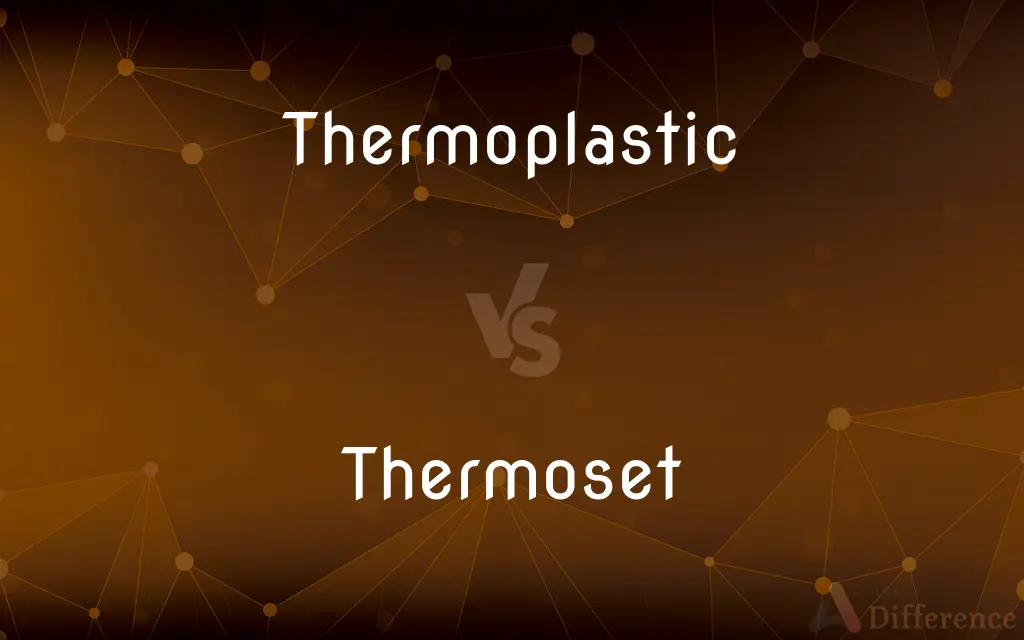Thermoplastic vs. Thermoset — What's the Difference?
By Fiza Rafique & Maham Liaqat — Updated on April 6, 2024
Thermoplastics can be reheated and reshaped multiple times without altering their chemical structure, whereas thermosets permanently set and cannot be remolded upon heating.

Difference Between Thermoplastic and Thermoset
Table of Contents
ADVERTISEMENT
Key Differences
Thermoplastics are characterized by their ability to melt when heated and solidify when cooled, a process that can be repeated multiple times. This property makes thermoplastics versatile for various applications, as they can be recycled and reshaped into new forms. On the other hand, thermosets undergo a chemical change when heated and molded, creating strong cross-linked bonds that set their shape permanently. Once set, thermosets cannot be remelted or remolded, making them durable but not recyclable in the same way as thermoplastics.
The reversible physical changes in thermoplastics are due to the linear or branched structure of their polymer chains, which allows them to become soft and pliable at certain temperatures. In contrast, the chemical process that cures thermosets, often initiated by heat, pressure, or catalysts, creates a rigid three-dimensional network of bonds that cannot be undone without breaking the material itself.
Thermoplastics are widely used in everyday items like plastic bottles, packaging materials, and toys due to their flexibility and recyclability. Thermosets, with their ability to withstand high temperatures and resist deformation, are used in applications requiring durability, such as electronic components, adhesives, and auto parts.
While thermoplastics offer the advantage of recyclability, their tendency to soften at higher temperatures can be a limitation in applications requiring heat resistance. Thermosets, while not recyclable through conventional means, provide superior thermal stability, making them indispensable in situations where material integrity at high temperatures is critical.
The choice between thermoplastics and thermosets depends on the specific requirements of the application, including the need for flexibility, durability, heat resistance, and recyclability. Innovations in material science are continually expanding the capabilities and applications of both types of polymers.
ADVERTISEMENT
Comparison Chart
Reheating and Remolding
Can be reheated and reshaped multiple times
Cannot be remelted or reshaped after curing
Chemical Structure
Linear or branched polymer chains
Cross-linked polymer chains
Recyclability
Recyclable, as they can be melted down and remolded
Not recyclable through conventional methods
Heat Resistance
Tend to soften or melt at high temperatures
Retain their strength and shape at high temperatures
Applications
Plastic bottles, packaging, toys
Electronic components, adhesives, auto parts
Compare with Definitions
Thermoplastic
Can be recycled and reshaped into new products.
Recycled PET bottles turned into polyester fibers.
Thermoset
Cannot be remelted or remolded after setting.
Phenolic resins in circuit boards and billiard balls.
Thermoplastic
Suitable for applications requiring reshaping.
Polycarbonate lenses for eyewear and safety goggles.
Thermoset
Offer superior heat and chemical resistance.
Silicone rubber for bakeware and kitchen utensils.
Thermoplastic
Common in everyday products due to versatility.
PVC piping for plumbing and construction.
Thermoset
Polymers that form a permanent shape after curing.
Epoxy resins used in adhesives and coatings.
Thermoplastic
Soften when heated, making them moldable.
ABS plastic used in 3D printing and toys.
Thermoset
Ideal for high-stress applications.
Fiberglass used in boat hulls and automotive bodies.
Thermoplastic
Polymers that become pliable at specific temperatures.
Polyethylene is used in plastic bags and wraps.
Thermoset
Not recyclable, but highly durable.
Urea-formaldehyde foam insulation in construction.
Thermoplastic
A thermoplastic, or thermosoftening plastic, is a plastic polymer material that becomes pliable or moldable at a certain elevated temperature and solidifies upon cooling.Most thermoplastics have a high molecular weight. The polymer chains associate by intermolecular forces, which weaken rapidly with increased temperature, yielding a viscous liquid.
Thermoset
A thermosetting plastic
Thermoplastic
Becoming soft when heated and hard when cooled.
Thermoset
Having the property of becoming permanently hard and rigid when heated or cured;
The phenol resins and plastics were the original synthetic thermosetting materials
Thermoplastic
A thermoplastic resin, such as polystyrene or polyethylene.
Thermoplastic
Softening when heated and hardening when cooled, and thus able to be moulded
Thermoplastic
A plastic with this property.
Thermoplastic
A material that softens when heated and hardens again when cooled
Thermoplastic
Having the property of softening or fusing when heated and of hardening and becoming rigid again when cooled;
Thermoplastic materials can be remelted and cooled time after time without undergoing any appreciable chemical change
Common Curiosities
Can thermoplastics withstand high temperatures?
Thermoplastics tend to soften or melt at high temperatures, which limits their use in applications requiring heat resistance.
What are thermoplastics?
Thermoplastics are polymers that can be melted and reshaped multiple times without altering their chemical structure, making them recyclable and versatile for various uses.
Are thermoplastics or thermosets more environmentally friendly?
Thermoplastics are generally considered more environmentally friendly due to their recyclability, though the environmental impact of both types of polymers depends on various factors, including production methods and lifecycle management.
How do manufacturers choose between thermoplastics and thermosets?
Manufacturers choose between thermoplastics and thermosets based on application requirements, including the need for flexibility, durability, heat resistance, and environmental considerations.
What are thermosets?
Thermosets are polymers that undergo a chemical reaction to form a rigid, cross-linked structure, making them durable and heat-resistant but not remoldable or recyclable in the same way as thermoplastics.
What makes thermosets ideal for electronic components?
Thermosets are ideal for electronic components due to their excellent thermal stability and resistance to deformation under high temperatures.
What are the latest trends in thermoplastic and thermoset applications?
Latest trends include developing biodegradable thermoplastics, enhancing the recyclability of thermosets, and creating materials with improved properties for specific industrial applications.
Why can't thermosets be remolded?
Thermosets cannot be remolded because their curing process creates permanent, cross-linked bonds that set their shape and cannot be undone without damaging the material.
Can innovations make thermosets recyclable?
Recent innovations are exploring ways to make thermosets more recyclable, including chemical recycling methods that break down the polymers into monomers that can be reused.
How are thermoplastics recycled?
Thermoplastics are recycled by melting them down and reshaping them into new products, a process that can be repeated several times for some materials.
Share Your Discovery

Previous Comparison
Maturation vs. Learning
Next Comparison
Kindle vs. TabletAuthor Spotlight
Written by
Fiza RafiqueFiza Rafique is a skilled content writer at AskDifference.com, where she meticulously refines and enhances written pieces. Drawing from her vast editorial expertise, Fiza ensures clarity, accuracy, and precision in every article. Passionate about language, she continually seeks to elevate the quality of content for readers worldwide.
Co-written by
Maham Liaqat













































